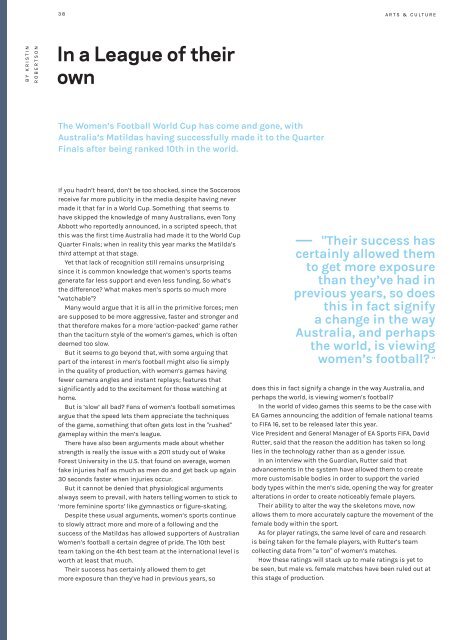Create successful ePaper yourself
Turn your PDF publications into a flip-book with our unique Google optimized e-Paper software.
38<br />
ARTS & CULTURE<br />
BY KRISTIN<br />
ROBERTSON<br />
In a League of their<br />
own<br />
The Women’s Football World Cup has come and gone, with<br />
Australia’s Matildas having successfully made it to the Quarter<br />
Finals after being ranked 10th in the world.<br />
If you hadn’t heard, don’t be too shocked, since the Socceroos<br />
receive far more publicity in the media despite having never<br />
made it that far in a World Cup. Something that seems to<br />
have skipped the knowledge of many Australians, even Tony<br />
Abbott who reportedly announced, in a scripted speech, that<br />
this was the first time Australia had made it to the World Cup<br />
Quarter Finals; when in reality this year marks the Matilda’s<br />
third attempt at that stage.<br />
Yet that lack of recognition still remains unsurprising<br />
since it is common knowledge that women’s sports teams<br />
generate far less support and even less funding. So what’s<br />
the difference? What makes men’s sports so much more<br />
"watchable"?<br />
Many would argue that it is all in the primitive forces; men<br />
are supposed to be more aggressive, faster and stronger and<br />
that therefore makes for a more ‘action-packed’ game rather<br />
than the taciturn style of the women’s games, which is often<br />
deemed too slow.<br />
But it seems to go beyond that, with some arguing that<br />
part of the interest in men’s football might also lie simply<br />
in the quality of production, with women’s games having<br />
fewer camera angles and instant replays; features that<br />
significantly add to the excitement for those watching at<br />
home.<br />
But is ‘slow’ all bad? Fans of women’s football sometimes<br />
argue that the speed lets them appreciate the techniques<br />
of the game, something that often gets lost in the "rushed"<br />
gameplay within the men’s league.<br />
There have also been arguments made about whether<br />
strength is really the issue with a 2011 study out of Wake<br />
Forest University in the U.S. that found on average, women<br />
fake injuries half as much as men do and get back up again<br />
30 seconds faster when injuries occur.<br />
But it cannot be denied that physiological arguments<br />
always seem to prevail, with haters telling women to stick to<br />
‘more feminine sports’ like gymnastics or figure-skating.<br />
Despite these usual arguments, women’s sports continue<br />
to slowly attract more and more of a following and the<br />
success of the Matildas has allowed supporters of Australian<br />
Women’s football a certain degree of pride. The 10th best<br />
team taking on the 4th best team at the international level is<br />
worth at least that much.<br />
Their success has certainly allowed them to get<br />
more exposure than they’ve had in previous years, so<br />
"Their success has<br />
certainly allowed them<br />
to get more exposure<br />
than they’ve had in<br />
previous years, so does<br />
this in fact signify<br />
a change in the way<br />
Australia, and perhaps<br />
the world, is viewing<br />
women’s football? "<br />
does this in fact signify a change in the way Australia, and<br />
perhaps the world, is viewing women’s football?<br />
In the world of video games this seems to be the case with<br />
EA Games announcing the addition of female national teams<br />
to FIFA 16, set to be released later this year.<br />
Vice President and General Manager of EA Sports FIFA, David<br />
Rutter, said that the reason the addition has taken so long<br />
lies in the technology rather than as a gender issue.<br />
In an interview with the Guardian, Rutter said that<br />
advancements in the system have allowed them to create<br />
more customisable bodies in order to support the varied<br />
body types within the men’s side, opening the way for greater<br />
alterations in order to create noticeably female players.<br />
Their ability to alter the way the skeletons move, now<br />
allows them to more accurately capture the movement of the<br />
female body within the sport.<br />
As for player ratings, the same level of care and research<br />
is being taken for the female players, with Rutter’s team<br />
collecting data from "a ton" of women’s matches.<br />
How these ratings will stack up to male ratings is yet to<br />
be seen, but male vs. female matches have been ruled out at<br />
this stage of production.


















